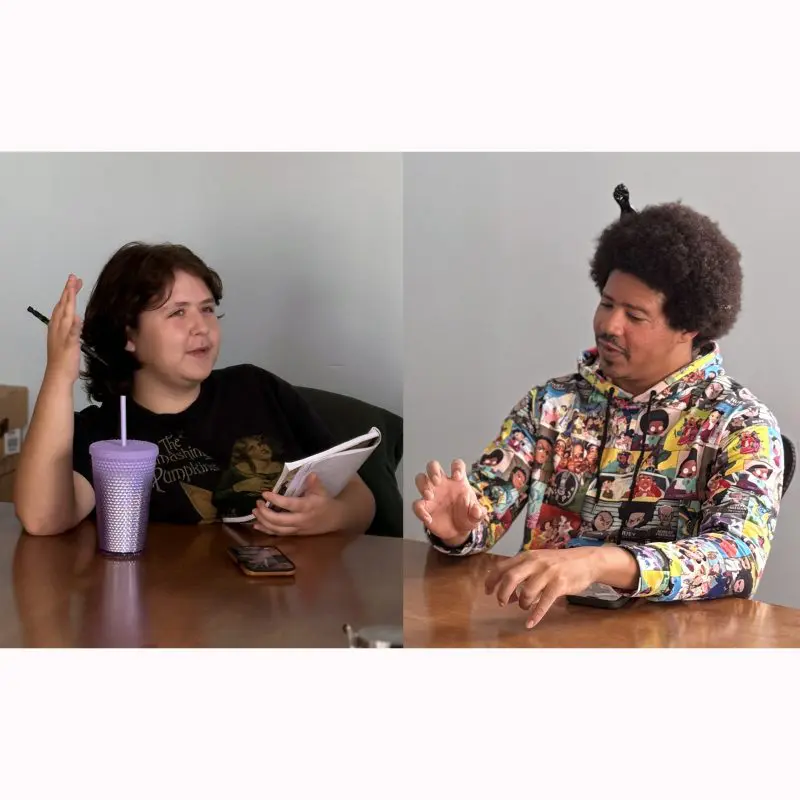Getting to Know Montserrat’s Faculty: Trevon Coleman
By Aislinn Green ’28
Montserrat has many quirks that make it an enticing option for new undergrads. There’s the beautiful scenery and lively small town setting, its wide array of facilities students can explore and experiment with, along with its extensive internship work, and guidance and preparation for graduates’ entrance into the job force. Another huge draw to MCA is the student-to-faculty ratio, which is about 8 students for every 1 faculty member. This small classroom size allows for a more intimate and personalized experience as students build upon their creative and academic skills. Montserrat’s faculty is a diverse team of interesting artists with unique skills, ideas, and perspectives, and it’s up to me to get to know some of these characters. This week I sat down with one of Montserrat’s newest staff members, Trevon Coleman, an Artist Educator Residency Mentor.
Trevon is a multi-disciplinary artist who has joined us here in Beverly from the University of Maryland, where he’s wrapping up his second MFA in Studio Arts. I asked him about the transition from a significantly larger university to itty bitty Beverly. “It’s very interesting…” he told me. Trevon has been kind of all over the place; he received his first MFA in film from the University of Iowa, and beyond that he’s got work experience in far more significant cultural nodes. “I worked in Orlando, Florida, for a long time. So, I was engaged with people from all over the world, and tourism,” He explained. Despite the drastic difference in atmosphere, it certainly hasn’t been an unwelcome change for him. “It’s very different, but the size allows for a more focused connection to what the students are doing. Rather than being in a classroom of 30 students, I’m in a classroom of 11. So, it makes it a lot easier to adjust the course to what the students are interested in.” The close, familiar environment that these small classroom sizes create really allows a symbiotic relationship to form between students and staff, where the students can learn from their professor in the way that is catered to their needs at the same time as their instructor is similarly learning the best way to run and facilitate their coursework and classroom content.
Trevon currently teaches two classes that are key to the freshman curriculum, Time-Based Practices and Contemporary Frameworks. Every student who has completed these courses knows how important it is to have a teacher who works alongside students and helps them explore different mediums, themes, and coaxes them out of their comfort zones. After speaking with him for a while, I was convinced that he was the perfect fit to teach these two courses. Trevon’s portfolio is wildly multidisciplinary, with materials ranging from personally excavated rocks and minerals, to fabric and textiles, to 16 mm film. As an artist who tries to explore as many mediums as possible (and a huge nerd) I was eager to pick his brain about his personal experience and perspective on some of these materials.
I asked him, “You have pursued two MFAs in two different fields: film and studio art– very cool. How has your experience with one medium, like film, influenced your approach to another, such as textiles or photography?”
After thinking for a moment, he replied: “When I work with any medium, oftentimes it is either to explore the medium itself and see what it can offer to an idea, or it’s to take an idea and see if I can break it apart into other areas.”
He continued, “with film and how it relates to other mediums for me.. I often take some of the ideas and theories behind film and media… and test them out in other areas, right? And so, a big thing that comes from the language of film, and photography, the frame, compositions, how we understand movement and time– it’s mirrored in comic books, and animation, and so on and so forth.
“And so I’ve taken comic books, and transferred them to 16mm film. And in that way I’m breaking apart both mediums, right, it’s not projected the same as a traditional film, but it also can’t be read like a comic book, it’s in between, and that in between space is where questions are… y’know, people who engage with it can ask well, what is a film? And now they’re asking questions that my film works ask them to ask… my studio projects ask people to ask, to become engaged bodily. So both ways that I use my practice, whether in a studio practice or a film practice, it’s trying to get the engagement from the audience.”
Being an artist that is so interested in exploring the synthesis of mediums, combined with the destruction and reconstruction of different mediums, Trevon seems to be the perfect figure to encourage students to branch out and explore new practices, to embrace the opportunities for experimentation that Montserrat offers. In fact, he is not only harboring the conditions for students’ multidisciplinary endeavors to flourish, he is also taking advantage of these conditions himself. Trevon is beginning to get acquainted with the sculpture studio over in 301 Cabot, going through training so he can get started creating and experimenting with new materials.
I asked him if he had a particular material that he had never worked with before that he was looking forward to getting up close and personal with in the future. He was stuck on even coming up with a material he had yet to use.
“Metal, and metal casting and everything. I am interested in that, but I am unsure of the scale I’m interested in. There’s something about having just learned ceramics and clay, and wheel throwing and– and hand building, about working with something you can go and dig up yourself. So, I am kind of interested in those processes as they extend to metal.”
Though MCA is a place that typically embraces the exploration of multimedia art and how different practices overlap, Trevon recognizes that it is common among high art institutions to try to limit oneself to one or two practices. “I think it helps to be able to think through ideas, um, in as many directions as you can, so that you can find the path to take, I think there is sometimes a misattribution to maybe doing too much, or having too many feelers out, but oftentimes it does let you find out which one is the one that the project needs,” he comments.
Trevon and I discussed the relationship between content and form when creating a piece, and how the form or material that the piece consists of can become interwoven with the meaning of the piece. This process of selecting a medium that best suits the piece is something Trevon is very familiar with in his work. His portfolio is full of works that are personal explorations of his experiences and identity, themes that are very integral to many of his pieces.
AZ: Going and deciding what medium different pieces call for, I think it is a really important part of the process that people overlook. But, speaking of mediums and using different mediums, your artist statement mentions exploring “black” as a medium, and as a language, and experience. So, for students who are just starting to develop their artistic journey, how would you describe the difference between using a subject in your work and using it as the medium in which you present the work?
TREVON: I think the goal is that they become inseparable… Specifically what I’m doing with “Black,” it is a charged word because it leans in these different spaces, it has a relationship to color, to– to how we perceive light and dark, and space, right? But it also has a sociopolitical connotation, and it also has a psychological connotation, it has all of these things and you’ll find a lot of words do, and so oftentimes what I do with separating material and subject is try to find how– where in this Venn diagram that they overlap. Black as a color in psychology is the color of fear, and of course this is a western lens, and then you look sociopolitically, “Oh– dangerous, criminal.” I can play with the idea of blackness and fear, and I can turn it on its head… And so, by using material that is soft, but still black, I am now playing with that idea of your fear. And by engaging with it, you challenge yourself, and so the material is kind of forcing you to address the subject in that way..”
Trevon showed up to our interview wearing a hoodie that was entirely covered in a pattern of all different cartoons, many of them from the 90s and 2000s. When I asked him about his inspirations and what content influences his creative process, I was honestly expecting a cartoon featured on the sweatshirt.
“The simple and not so simple answer is people,” he told me. “I have been a caricaturist for over 20 years now, and I have sat in a chair across from a person drawing them while having conversation with them, and the amount that I have learned from that exchange, the amount that I have gained from that exchange… kind of beats everything else. Like, hundreds of thousands of conversations with regular people… and everyone’s regular people, but I just mean like… strangers! And I’m drawing that stranger– “What do you like? What are you into?”– and they talk about it, and eventually some people get into like their lives and where they come from, what they do, and all this stuff.” Trevon explained that these exchanges have really gotten him to think through his work.
After my conversation with Trevon, I definitely understand why the exchanges he’s had with others have been so influential to him and his work. Simply talking to him about his perspective, his processes, and his background, I’ve broadened my own horizons to concepts and ideas that I had never considered before. He began his artistic journey worlds away from where I began my own, and yet despite the geographical, cultural, demographical differences between us, there we sat for a little while, together, discussing art and culture and community, united through our craft. Montserrat is a nursery for this sort of connection, with its diverse, vibrant collection of unique artists with different backgrounds and futures. If you sit down with one of your professors and you ask them about their artistic process, or what inspires them, or whatever you’re curious about, I’ll bet you’ll hear one thing that you’ll think about for the rest of your life. Go ahead, try it! Or, you could leave the talking to me, and stay tuned for the next interview.


